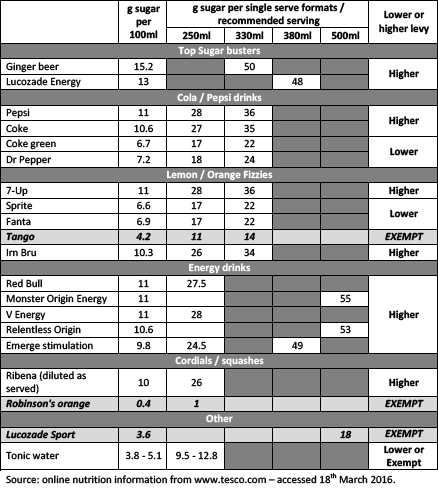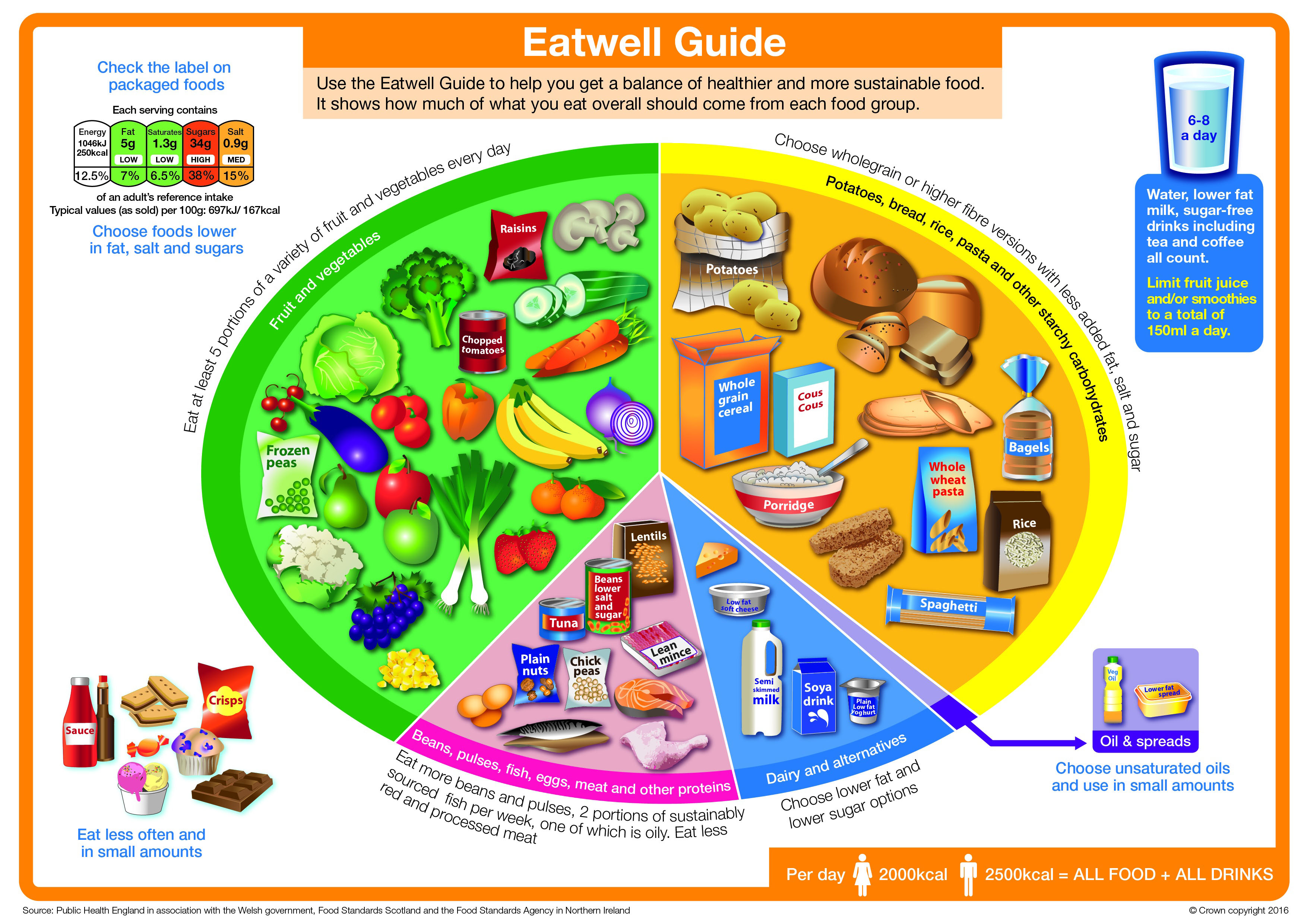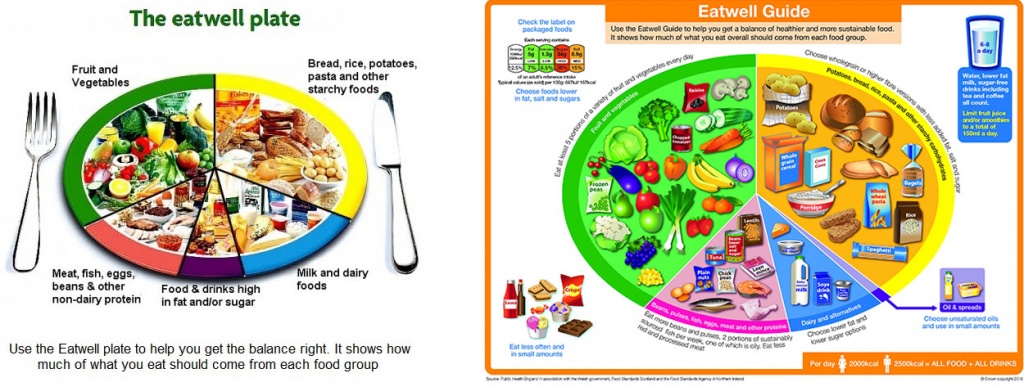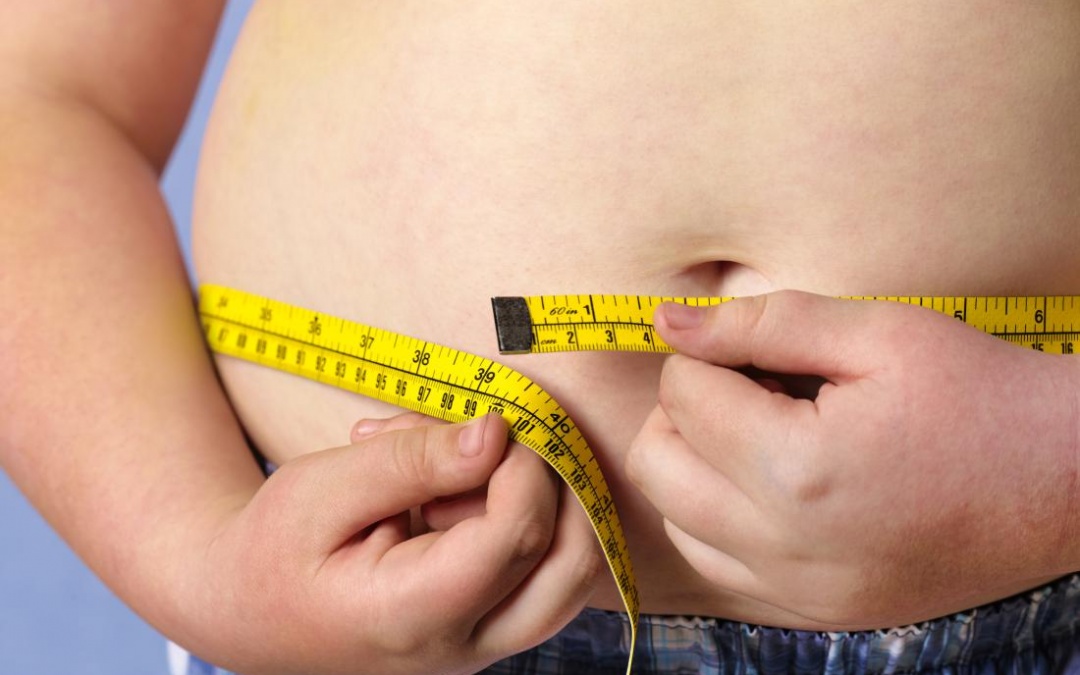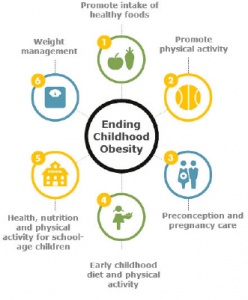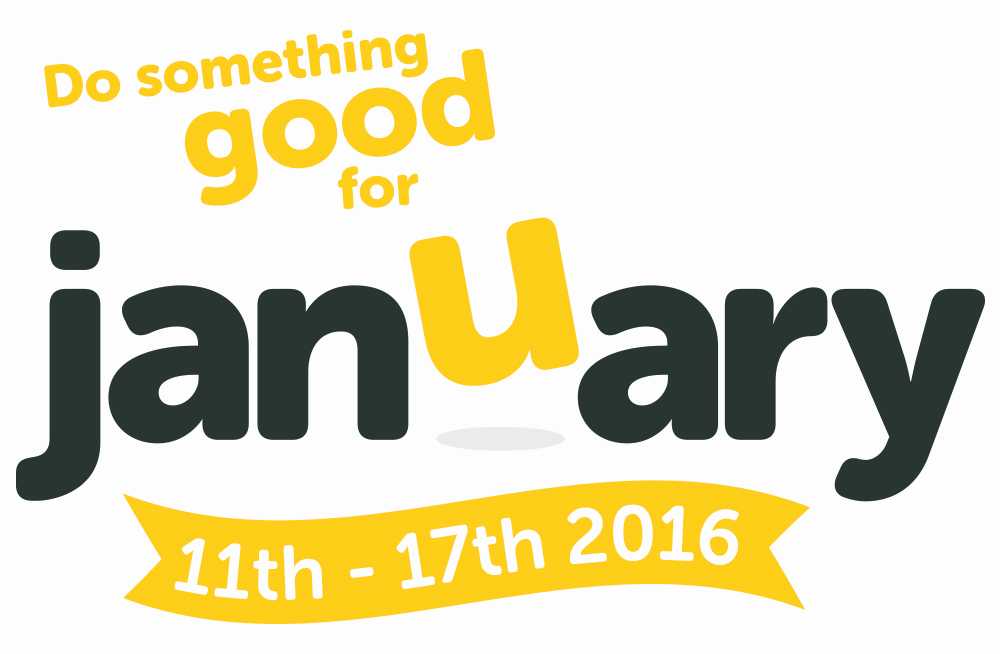
by Nutrilicious | Mar 21, 2016 | Hot Topics in nutrition
Wednesday 15th March saw the nation’s health top of the government agenda with the launch of the new Eatwell Guide and more surprising, the new budget announcement declaring a tax for sweetened beverages.
We are still in the dark about the how much tax will be added, but it is thought that it will be set at the PHE recommendation of 20%, despite the National Obesity Forum recommendation to set it at 50% if any impact on behaviour change is to occur.
Which soft drinks will be hit?
Two tax levels will be set. One for soft drinks providing more than 5g sugar per 100ml and a higher levy for those providing more than 8g sugar per 100ml. The table below indicates how the current soft drinks market will be taxed.
Nutrilicious feels that single serve formats should have been taken into consideration when setting the sugar benchmarks, similarly to front of pack traffic light labelling. As an example, sports drinks are only available as a single 500ml serve bottle providing a total of 18g sugars, yet because they contain less than 5g sugar per 100ml, they will be exempt. This could be argued by other soft drinks companies as unfair. Many that will be taxed for containing over 5g or 8g sugar per 100ml, offer much small single serve formats, limiting the total serve sugar intake to the same as sports drinks and sometimes less.
Exemptions: fruit juice, milk drinks and small producers. This does muddy the waters somewhat as the government in its new sugars recommendations classified fruit juice as a ‘free sugars’ source and why are small producers exempt if they do produce high sugar drinks? Not quite an even playing field and this will not encourage innovation for lower sugar products from companies who will be exempt. Also, what does ‘milk drinks’ refer to? Will sugar laden flavoured milk drinks be exempt?
When will it be enforced? The tax will come into force in April 2018, giving manufacturers adequate time to reformulate their drinks and / or change their offerings to consumers. Many could try to reduce their sugars from the higher to the lower levy benchmark.
Will this reduce consumer purchase of higher sugar soft drinks? Possibly not, but the government is banking on this levy to add over £500 million to the economy which will be used to:
- Double the primary school PE and sport premium.
- Give 25% of secondary schools increased opportunity to extend their school day to offer a wider range of activities for pupils, including more sport.
- Expand breakfast clubs in up to 1,600 schools.
So, Jamie has won the battle to place taxes on sweetened drinks and this will be welcomed by health organisations even though many of them wanted to see a significantly higher levy. We do feel that a more even playing field should have been set and all high sugar drinks, including fruit juice and drinks from small producers, should have the levy enforced. In addition, single serve formats should be considered when assessing sugar levels. If anything, this could go a long way to help prevent consumers’ from being misled by marketing claims that a soft drink ‘is full of / provides energy’. A clever abuse by some manufacturers regarding consumer’s misunderstanding of the word ‘energy’ relating to healthiness rather than empty unnecessary calories. We look forward to more specific details.
A selection of current soft drinks on the market, their sugar content per 100ml and their single serve format or recommended serving size and which tax level they will incur in April 2018.

Sugar Drinks details
For further information on the 2016 budget: www.gov.uk/government/publications/budget-2016-documents/budget-2016

by Nutrilicious | Mar 18, 2016 | Hot Topics in nutrition
Kept under much secrecy, the government revealed the updated Eatwell Plate to the nation on Thursday 17th March following a stakeholder meeting on Wednesday 16th , which we were pleased to attend. Surprising for us, the changes to the new Eatwell Guide went beyond some simple cosmetic adaptations. In the main, the plate, based on exhaustive reviews of the scientific evidence, has embraced more of the 21st Century consumer eating trends and the growing concerns around sustainability. Will it be more effective at improving the population’s poor nutritional status and reduce obesity? As with all dietary guidelines, effective communication and behaviour change strategies that follow will be key.

Can you spot the 13 differences?
The official documentation lists 12 differences, however, we’ve added one more!
- Importance of hydration has finally been embraced! With recommendations to consumer 6-8 glasses of fluid daily: water, sugar free drinks including tea and coffee and milk.
- Front of pack labelling: possibly coming to terms that as much as we would love the nation to be keen cooks, ready meals and take-aways are by far more popular.
- High fat, salt and sugar foods removed altogether: ‘no role in a healthy balanced diet.’ At last, the group that also included healthy unsaturated fat oils and spreads has been better clarified with latter remaining within the Eatwell Guide as a much smaller section (taking up just 1%).
- Calories have been included for adult men and women – to remind consumers that all foods contribute to calories.
- Four of the five food segments renamed: changing the emphasis to embrace more wholegrains and plant foods whilst keeping saturated fat down.
• Bread, rice, potatoes pasta and other starchy foods is now ‘Potatoes, bread, rice, pasta and other starchy carbohydrates’ with an overarching sub-line ‘Choose wholegrain or higher fibre versions with less added fat, salt and sugar.’
• Milk & dairy foods is now ‘Dairy & alternatives’ with the sub-line ‘Choose lower fat and lower sugar options.’
• Meat, fish, eggs, beans and other non-dairy sources of protein is now ‘Beans, pulses, fish, eggs, meat and other proteins’ with the sub-line ‘Eat more beans and pulses, 2 portions of sustainably sourced fish per week, one of which is oily. Eat less red and processed meat.’
• Food and drinks high in fat, sugar and/or salt has now been removed and instead replaced with ‘Oil & spreads’.
- The five food segments re-sized:
• Fruit and vegetables – go up by 7%, now making up 40% of the plate.
• A bigger push for wholegrain carbs – and up by 5% to 38% of the plate. We hope this will help towards the fight against the ‘anti-carb-based on dodgy and misinterpreted science’ brigade. – As well as wholegrain, there is more emphasis (we feel within the full guidance notes) that it’s not carbs that are fattening but what we choose to add to them.
• Dairy and alternatives – almost halving the recommendations from 15% down to just 8% of the plate. We are pleased to see calcium fortified and unsweetened dairy alternatives making a bigger noise here. And interestingly, 1% dairy milks are recommended over semi-skimmed.
• Protein segment making up the same proportion as previously, has significantly been revamped to embrace sustainability and the need for more plant-based protein consumption. With ‘other proteins’ including soya and Mycoproteins. Single portions of meat to be 70g and fish to be sustainably sourced.
- Fruit juice removed from the Eatwell Guide fruit and vegetable visual in this sector, but highlighted in the hydration section with a significant emphasis that no more than 150ml daily consumption.
- Smoothies have lost their halo: previously, smoothies were permitted to count as 2 of our 5-a-day at 125ml per portion. With both smoothies and fruit juice now classified as ‘free sugars’ the consumption of either has been clearly limited to no more than 150ml per day as part of hydration and contributing to just one of our 5-a-day.
- Oils and spreads: now making just 1% of the Eatwell Guide and thankfully no longer considered as part of the high fat, salt and sugar foods. There is good emphasis within the guidance that all fats however add cals and should be limited.
- Additional messages for further guidance – helping consumers better understand the visuals including 8 tips for healthy eating.
Some changes based on qualitative stakeholder and consumer insights, but considered more cosmetic by us:
- No fork and knife
- Change of name from Eatwell Plate to Eatwell Guide
• Both the above changes based on insights that they little reflect how consumers see meals / consume foods.
- Drawn food images rather than photography. Interesting insight that although stakeholders prefer the latter, consumers prefer the former.
Great strides – but will it be enough?
We are disappointed that there continues to be no offer of practical and household portion guides particularly for the carbohydrate and some foods from the protein groups. This will make it difficult for both the consumers and health advisors to provide the real practical much needed approach. We appreciate that it is a challenging task but believe it to be achievable. As Dietitian communicators in public health we are aware of how much the public needs to be shown how to put these guidelines into practice and how much a consistent approach is needed. PHE at the stakeholder meeting mentioned that they have done some preliminary work on this internally but such things like meal plans will not currently feature in the tools and communications, due largely to lack of funding. We were also surprised that no quantitative survey work representative of the population and health advisers using the tool had not been undertaken prior to the focus group work. Perhaps if this had been done these needs would have been prioritised and addressed.
Will this change the health of the nation?
It will all depend on how and who it’s communicated to and what behaviour change strategies will be put into place which as we all know, means funding. With Cameron’s Obesity Strategy expected to be announced in 2016, how much funding is put behind such campaigns will be the true sign of how seriously they are about tackling the health of the nation.
www.gov.uk/government/publications/the-eatwell-guide

by Nutrilicious | Feb 3, 2016 | Health Awareness Events, Hot Topics in nutrition
As weight-busting January came to an end it brought to light a new, hard-hitting report from the WHO Commission on Ending Childhood Obesity (ECHO), with the alarming headline that, globally-speaking, at least 41 million children aged under five years are obese or overweight (1).
Applying the emergency brake on obesity: Whose role is it?
Unsurprisingly, The ECHO report, based on a review of the evidence, highlights childhood obesity as a complex and multidimensional problem. However, according to the report, the greatest obstacle to effective progress on reducing childhood obesity is a lack of political commitment and a failure of governments and other actors to take ownership, leadership and necessary actions. The WHO calls on governments to take effective leadership on obesity by incorporating large-scale cultural environmental and behavioural change without which change simply will not happen.
The knowns
We know that obesity has a massive impact on a child’s quality of life, from physical as well as psychological perspectives; studies also show that obese children face significant risk of obesity in adulthood, which itself poses major health and economic consequences for families and wider society (2).
The report paints a bleak picture that the prevalence of children being overweight under the age of five has risen, from 4.8% in 1990 to 6.1% in 2014, or an increase of 10 million children. On closer scrutiny, the statistics reveal that the most significant change in prevalence has been in Asia and Africa, driven by globalisation and urbanisation leading to obesogenic environments. Another major driver highlighted was the marketing of ‘unhealthy foods and non-alcoholic beverages’ which feature heavily in the recommendations.
The answers
The report proposes a set of policy recommendations to address three strategic objectives:
- To tackle the obesogenic environment and norms.
- To reduce the risk of obesity during critical periods in the life-course —preconception and pregnancy, infancy and early childhood, and older childhood and adolescence.
- The provision of treatment for children who are obese to improve their current and future health. To unpack this further, six broad recommendations are highlighted:

1 Promote intake of healthy foods
Implement comprehensive programs that promote the intake of healthy foods and reduce the intake of unhealthy foods and sugar-sweetened beverages by children and adolescents.
2 Promote physical activity
Implement comprehensive programs that promote physical activity and reduce sedentary behaviours in children and adolescents.
3 Preconception and pregnancy care
Integrate and strengthen guidance for the prevention of non-communicable diseases with current guidance on preconception and antenatal care.
4 Early childhood diet and physical activity
Provide guidance on, and support for, healthy diet, sleep and physical activity in early childhood and promote healthy habits and ensure children grow appropriately and develop healthy habits.
5 Health, nutrition and physical activity for school-age children
Implement comprehensive programmes that promote healthy school environments, health and nutrition literacy and physical activity among school-age children and adolescents.
6 Weight management
Provide family-based, multi component, lifestyle weight management services for children and young people who are obese.
While the report highlights, the limited potential of any single intervention to provide a solution, within these overarching recommendations are more specific targets, focussed on tackling the obesogenic environment.
Targets for the food industry feature prominently. Within the first recommendation, there is a call to implement ‘effective taxation on sugar-sweetened beverages’ and to implement context-specific nutrition information, and ‘interpretive’ front-of-pack labelling. The food and drink industry, retailers and marketing stakeholders are called upon to clampdown on junk food marketing with the report recommending that advertisements for ‘unhealthy products’ should be banned from children’s TV, schools and sports facilities. Sizing up is also singled out as a particular issue to address and there is scope and opportunity for the industry to address appropriate portion sizes.
Schools also offer a key opportunity for action and the report’s recommendations focus on: standards for school meals; elimination of so-called ‘unhealthy foods’, such as sugar-sweetened beverages and energy-dense, nutrient-poor foods, in the school environment; informed nutrition education as part of the core curriculum; and ensuring levels of physical activity for all children, meet current recommendations, with comprehensive programmes that reduce sedentary behaviours in children.
Similarly, health professionals have a major role to play if the recommendations are to be in any way implemented which will take considerable investment in the work-force to achieve the skill-sets required, as well as the resources. The roles that schools and health professionals have to play can only be realised by ensuring that there are measures and funding in place to support them. Even before birth, the behavioural and biological responses of a child to the obesogenic environment can be shaped by processes (3). x7Hanson, MA and Gluckman, PD. Early developmental conditioning of later health and disease: physiology or pathophysiology?. Physiol Rev. 2014; 94: 1027–1076 CrossRef | PubMed | Scopus (30)See all References7 Having clear guidelines which start to tackle that environment is a starting point with independent research being used to show what works. This must start with giving schools and health professionals the support to run evidence-based interventions: for example, dietitians having a role in ante-natal settings to advise mothers-to-be on healthy diets for themselves, and as gatekeepers for the whole family; schools to have teachers who are able to deliver nutrition education as part of the curriculum, as well as giving space in the school environment for more movement. One of the recommendations is to ‘make food preparation classes available to children, their parents and caregivers’ – even to achieve this single measure, vast investment and training is needed.
Caterers also have a crucial role, especially those working within the public sector such as in schools and hospitals and early-years settings and are called upon to meet the recommendations to limit consumption of foods high in fat, sugar and salt; ensuring availability of healthy foods.
Getting to the known unknowns
Whilst some of the report’s recommendations are in place already in the UK, for example, the National Child Measurement Programme to help monitor weight changes http://www.nhs.uk/Livewell/childhealth1-5/Pages/ChildMeasurement.aspx the UK has yet to put in place resource for dealing with those found to be overweight as well as making recommendations for weight gain in pregnancy. Research priorities are needed so that the evidence is in place to make UK-specific recommendations. But, as the McKinsey report (5) highlighted, lack of research should not be a barrier to action.
So does accountability now lie within government versus local communities, individual responsibility etc? We have long known and as the ECHO report states ‘without joint ownership and shared responsibility, well-meaning and cost-effective interventions have limited reach and impact’. However, this joined up thinking and action has never happened and is unlikely to happen without clear co-ordinated leadership, appropriate powers and accountabilities with specific targets. Will Cameron now lead us with a ground breaking strategy for the UK that is lead right from the top with a COBRA style committee to truly address the nation’s health crisis in his forthcoming childhood obesity strategy? Will he be brave or will he leave it to his successors to sort out? No government has ever achieved this to date. Yet we have never needed it more than it is needed now. Let’s hope he has his eyes wide open on and the determination focus and foresight needed.
References
Commission on Ending Childhood Obesity. Report of the Commission on Ending Childhood Obesity. World Health Organization, Geneva; 2016 http://www.who.int/end-childhood-obesity/en/ (accessed Jan 29, 2016)
Litwin, SE. Childhood obesity and adulthood cardiovascular disease: quantifying the lifetime cumulative burden of cardiovascular risk factors. J Am Coll Cardiol. 2014; 64: 1588–1590
Hanson, MA and Gluckman, PD. Early developmental conditioning of later health and disease: physiology or pathophysiology? Physiol Rev. 2014; 94: 1027–1076
van Jaarsveld CHM, Gulliford MC. Childhood obesity trends from primary care electronic health records in England between 1994 and 2013: population-based cohort study. Arch Dis Child. doi:10.1136/archdischild-2014-307151
McKinsey Global Institute. Overcoming Obesity: An Initial Economic Analysis. McKinsey Institute; 2014 http://www.mckinsey.com/Insights/Economic_Studies/How_the_world_could_better_fight_obesity (accessed Feb 3, 2016)

by Nutrilicious | Jan 14, 2016 | Health Awareness Events, Hot Topics in nutrition
The National Obesity Forum has called for a tax on sugary drinks this week at more than double the level recommended by Public Health England, in a manifesto to improve public health launched to mark the beginning of its JanUary campaign (formerly National Obesity Awareness Week). The manifesto was presented at the All-party Parliamentary Group on Adult and Childhood obesity at the House of Commons re-launched today which we attended.
The Forum, which comprises of practicing healthcare professionals and clinicians, has claimed that only a 50 percent tax on sugary drinks will prompt a change in consumer behaviour. It has, however, rejected calls for a tax on food products, claiming such a move would unfairly penalise low-income families – instead insisting the Government should abandon the Responsibility Deal and mandate the reformulation of foods to reduce levels of fats, sugars and salts.
Other recommendations in the Forum’s manifesto, include GPs routinely measuring the weight and BMI of young children, including water in Public Health England’s relaunched ‘eat well’ plate, banning fast food outlets near schools, and insisting on a watershed ban for junk food advertising.
The Forum has also called for the expansion of specialist non-surgical weight management treatment services across the UK, and improved information on local weight management resources and services for GPs and nurses.
Professor David Haslam, Chairman of the National Obesity Forum, said: “The measures we’ve proposed could be relatively easily implemented with substantial benefits to public health. There have been repeated warnings about the health of the population, but we remain in the midst of an obesity epidemic. Tackling this problem requires immediate and concerted action. We need to improve and extend the treatment services available. We also need to educate and, where appropriate, change consumer behaviour.” “Anything less than a 50 percent tax on sugary drinks will be insufficient as a disincentive to consumers. We don’t currently support taxing food products – this would be unfair to particularly low-income families. But sugary drinks have no place in anyone’s diet.”
Unfortunately this meeting was very poorly attended by MPs. Let’s hope that this is not a sign of things to come with Cameron’s much anticipated childhood obesity strategy.
The National Obesity Forum is encouraging members of the public to make healthy New Year’s Resolutions and participate in a sugar reduction challenge as part of the JanUary campaign.
www.jan-u-ary.co.uk
www.jan-u-ary.co.uk/wp-content/uploads/2016/01/NOF-manifesto-v4-compressed.pdf

by Nutrilicious | Nov 11, 2015 | Hot Topics in nutrition, The Nation’s Health
Initial thoughts on the recent PHE Report: Sugar Reduction: The evidence for action
Many realists thought it unthinkable, but it happened, the Scientific Advisory Committee on Nutrition (SACN) recommended that sugar recommendations should be halved. Although many have tried to refute it, the evidence is strong for sugar and dental caries and however anyone tries to pull apart the publications associating sugar intake and weight gain, common sense and practical experience tells us, drinking litres of liquid sugar without any other nutritional benefit is not going to help with our struggle against obesity.
Nevertheless, halving sugar recommendations to no more than 5% of energy intake although aspirational may be a tall ask for many. Some have suggested it unachievable unless applied in a controlled environment where all sugar containing foods are banned. So let’s look at the facts and the plans now in place for achieving this.
Current sugar intakes exceed the old DRV recommendations of no more than 10% energy. Adults were not far off at 11.5%, the issue was with young children and teens with intakes of 14.7% and 15.4% of energy intake respectively. With the new guidelines, we are expecting adults to be able to reduce their sugar intakes by over half and children and teens by three-quarters…that does seem like a tall ask.
Which are the main culprits?
Food contribution to Non-Milk Extrinsic Sugar (NMES) intakes

Source: National Diet and Nutrition Survey Results from Years 1, 2, 3 and 4 (combined) of the Rolling Programme (2008/2009 – 2011/2012)
Not surprisingly soft drinks are the major contributors to sugar. Other unsurprising contributors are biscuits, cakes, pastries, buns plus obvious sugar and confectionary sources. Surprisingly however, fruit juice is also a key contributor, particularly for the very young. Some health professionals in the past have criticised attacks on fruit juice as it can help contribute to the nation’s 5-a-day. Fruit juice does have a halo effect for contributing to the UK’s vitamin intakes. According to the latest NDNS data, fruit juice contributes towards 14-19% of vitamin C intakes for 4-18 year olds and 12% for adults. However, soft drinks such as energy drinks, cordials and fruit drinks, contribute similar amounts of vitamin C – 18-20%. Whole fruit and vegetables remain top vitamin C contributors. Apart from the vitamin C contribution, fruit juice is not a significant contributor of any other vitamins or minerals, nor is it a source of fibre – a common myth (smoothies would on the other hand contribute to fibre intake). In addition, it’s interesting to note that vitamin C in bought fruit juice is due to fortification and not naturally derived from the fruit source. Based on these facts, soft drinks and fruit juice are not dissimilar, in that they are both a liquid form of concentrated sugar and contribute up to a fifth of vitamin C intakes.
PHE report on a rapid review of the evidence to assess the relationship between fruit juice consumption and health including cardiovascular disease. It reports that the very limited evidence shows no benefit or no harm. However, shouldn’t a review now consider the nutritional composition of fruit juice and its contribution to nutrient intake? This doesn’t appear to have been included. PHE report on how advice has been strengthened to limit consumption of fruit juice to no more than one portion a day i.e. 150ml. However, if 150ml of fruit juice is adhered to, which is highly unlikely given that only 1% of the population currently meet healthy eating guidelines, this in itself will provide approx. three teaspoons of sugar, making up 60% of the recommended maximum free sugars for 4-6 years and 50% in those 7-10 years. A more detailed review of advice in relation to fruit juice seems warranted, particularly in relation to children’s diets.
How can the nation so drastically lower their sugar intakes?
How the government aims to achieve this is through 8 key strategies, published by the PHE on the 22nd October 2015:
- Reduce price promotions on high sugar drinks and foods (in all retail and out of home sections including supermarkets, convenience stores, restaurants, cafes and takeaways).
- Significantly reduce opportunities to market and advertise high sugar food and drink products to children and adults across all media including digital platforms and through sponsorship.
- Set a clear definition for high sugar foods to aid with actions 1 and 2 above. They aim to review and update the 2011 Ofcom nutrient profiling model5.
- Gradual sugar reduction in everyday food and drink products, combined with reductions in portion size.
- The sugar tax. A price increase of a minimum of 10-20% on high sugar products through the use of a tax or levy such as on full sugar soft drinks.
- Government buying standards for food and catering services (GBSF) across the public sector, including national and local government and the NHS to ensure provision and sale of healthier food and drinks in hospitals, leisure centres etc.
- Accredited training in diet and health for all who have opportunity to influence food choices in the catering, fitness and leisure sectors and others within local authorities.
- Continue to raise awareness of sugar to the public as well as health professionals, employers, the food industry etc., encourage action to reduce intakes and provide practical steps to help people lower their own and their families’ sugar intake.
Much of the above makes sense and we look forward to seeing how all of this will be actioned. It comes as no surprise that no single action will be effective in reducing sugar intakes and it’s positive to see much direction for change in terms of the environmental drivers of poor diets. In the meantime we have a number of initial thoughts.
PHE in their report highlight the lack of evidence for a sugar tax where many experts do not support this as an effective strategy. Food tax has failed in some countries where there is limited data for success in others. Placing a 10-20% tax on a cheap commodity such as soft drinks, would surely have little impact on sales where many individuals will simply seek out cheaper own brand alternatives.
While we don’t believe a sugar tax in itself will change sugar intake, any revenue generated from the tax could be put into other actions on reducing sugar intake. However, the halo effect from the extensive media headlines on sugar tax may have in itself already started to impact on inspiring lower sugar food choices. We all know the impact of “celebrity”. However the end impact is rarely positive when it comes to celebrity and public health nutrition. It’s not surprising that Jamie Oliver is once more being regarded as a public health nutrition “angel”.
Banning advertising of sweetened foods and drinks should have come in a long time ago. We know how powerful this tool is, especially for confusing the public with ‘skewed’ health and nutrition claims that seem to by-pass current legislation.
What’s missing?
What could be lacking from the government’s 8-point strategy, is the inclusion of more ‘enforced nudging strategies’ in all retail and out-of-home outlets selling sugary drinks and foods at point of purchase and in areas where there is the highest consumption. Removing high sugar foods and drinks from end of aisles and till points are mentioned. However, very little weight is given to this in the summary, despite that fact that this strategy has been proven to work in many scenarios both in the UK and abroad. Many corner shops and out-of-home food establishments have a limited range of ‘sugar free’ drink variants, bottled water is often highly priced, and point of purchase is often adorned with high sugar / fat /salt snacks and in some well-known establishments, 500g chocolate bars are aggressively promoted.
Another dichotomy is the drive for industry sugar reductions within major sugar contributors such as confectionary, cakes, biscuits and sweetened drinks. While this is needed as an immediate and realistic solution (changing peoples’ behaviour and eating habits will take a number of generations!), on its own, it cannot help towards improving the overall dietary and lifestyle habits of individuals. Swapping like with like will not educate or help change behaviour to enjoy and consume sugar / high fat foods in moderation nor can it empower the most in need to increase fruit and vegetable, water, wholegrains, oil-rich fish and plant-based protein intakes and be more physically active. This is an important factor that needs to be incorporated into any responsible reformulation programme and subsequent communication plans.
There are of course a number of challenges associated with removing sugar from a food or drink product and there little mention of this in the report. Positively industry have already been reformulating and achieving significant reductions in the sugar content of foods and drinks already, particularly in relation to retail own brands. A range of solutions have been employed which include the use of high intensity sweeteners, some bulking agents alongside some fibres. Adding fibre successfully provides a big opportunity for businesses and public health where the population are not eating enough fibre and where SACN has recently recommended increases in daily intakes. These of course all come with various challenges which need to be considered in full before embarking on re-formulation. The use of sweeteners for example are tightly regulated at EU level. There are restrictions for use on some sweeteners in some food groups. Claims in relation to sugar reduction are also tightly regulated. Importantly the other challenge is to reformulate in ways that still deliver on the consumer expectation for taste. A challenge for all industry members and particularly medium and start-up companies of course will be cost of re-formulation.
Competent training in diet and health for the wider workforce has been hugely welcomed at Nutrilicious. This is a key passion and area of work for us. The power of many occupations and individuals to influence the diet and health of those they have contact with is enormous. Yet many lack training. Guidance on how to achieve this is mentioned but one of the key stumbling blocks for most which is funding is not addressed in this report.
Something we feel PHE failed to tackle, possibly due to the enormity of the task, is food labelling. Regulations and guidance for front and back of pack labelling stipulates that ‘Total’ sugar must be shown. There are justifiable technical reasons for this. With the increase of front of pack traffic light labelling and encouragement of its use by the government, this is bound to thwart any attempts by individuals to fully grasp which sugars they should be avoiding and more importantly, the importance of nutrient dense foods. Focusing on just sugar content on food labels, the consumer could not be blamed for choosing digestive biscuits over an individual portion of nuts and raisins. The former would be traffic light coded amber for sugar and display 17.5g sugar per 100g (or 4.6g per 2 biscuits) whilst a 25g nuts and raisins pack would be traffic light coded red for sugar and display 34g sugar per 100g (8.5g per serve). How are we helping the consumer understand that the latter will not contribute to ‘free sugars’ and more importantly, it would help towards meeting the new increased fibre recommendations, provide heart healthy fats and some minerals. How confusing can it be for a consumer to see plain dairy yogurt with amber traffic light for sugar at 7.5g per 100g. Is there now a real need for the UK to adopt front of pack traffic light labelling for sugar to only include added sugar?
Focusing more on positive messages about foods rather than individual nutrients must be a major part of the way forward. And to drive positive food choices, it would be paramount to make naturally healthier foods more attractive and readily available whilst reducing the shelf space in stores of highly processed high sugar and fat foods with little other nutritive value.
Driving healthy food choices involves nudging people in the right direction as well as helping them to learn how to achieve a healthy balanced relationship with all foods and drinks (not nutrients). All stakeholders across multiple sectors and channels can play their own unique role in this and its exciting times for those developing and creating new food and health strategies and engagement plans for better health and business.
While lots of thoughts questions and ideas abound, we welcome PHEs report on sugar reduction. We look forward to working with relevant partners in contributing to the action and seeing how all of this will be implemented and monitored so that the 5% target can be achieved in 10 years.
At this date PHE have kindly agreed for us to interview them in January 2016 about this report and we look forward to exploring our thoughts and questions further on this hot public health strategy.
https://www.gov.uk/government/publications/sugar-reduction-from-evidence-into-action

